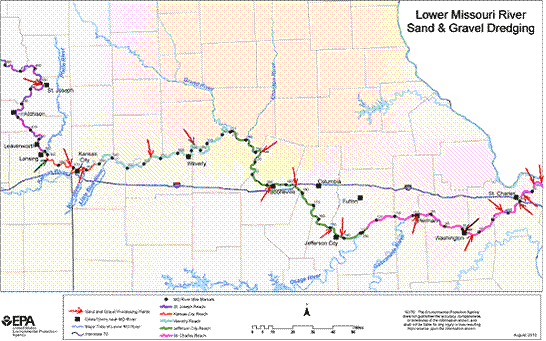Fact Sheet
September 2010
Missouri River Sand and Gravel Dredging
This fact sheet will assist you in understanding the EPA Region 7 action on a proposal to allow sand and gravel removal from the Missouri River. The proposal would allow the removal of 11.6 million tons per year of main channel river bottom material.
What is the federal action?
The U.S. Army Corps of Engineers (USACE) received 11 permit applications from eight dredging companies for Department of Army permits under the Rivers and Harbors Act and the Clean Water Act to dredge sand and gravel from the Missouri River below Rulo, Neb. Sand and gravel is used for construction purposes, particularly highway construction, and demand is heaviest near cities such as Jefferson City, Kansas City, St. Charles and St. Joseph, Mo.
The issuance of these permits is a federal action requiring analysis of the environmental impact of this action under the National Environmental Policy Act (NEPA). The USACE has determined that this action could have significant impact on the environment and requires completion of an Environmental Impact Statement (EIS). The USACE has evaluated the environmental impacts of commercial sand and gravel dredging on the lower Missouri River by developing five alternative actions, including the approach requested by the permit applicants. The five alternatives evaluated by the USACE are based on varying amounts of dredged sand and gravel, including a no dredged option, and lesser amounts than were requested in permit applications.
Where is dredging occurring?
- River Mile 498 at Rulo, Neb., to River Mile 0 at St. Charles, Mo.
- Involves permits issued by two Corps Districts: KC District, St. Louis District
- Key areas of interest include St. Joseph, Kansas City, Jefferson City and St. Charles

Why is EPA taking this action?
- EPA is required under NEPA and the Clean Air Act (Section 309) to review and rate the project and the draft EIS (DEIS) document
- EPA has rated the draft EIS document as not possessing sufficient information upon which to issue these permits (i.e., a Category 2 rating)
- EPA has also rated each of the alternative actions, including Environmentally Unsatisfactory (EU) for the applicants requested dredging quantities and the amount of dredging currently permitted on the lower Missouri River (Alternative C)
Alternatives |
Materials Excavated | EPA Rating |
No Action |
0 |
Lack of objections (LO) |
Proposed Action |
11,615,000 MT |
Environmentally Unsatisfactory – Insufficient Information (EU-2) |
Alternative A |
2,190,000 MT |
Environmental Concerns –Insufficient Information (EC-2) |
Alternative B |
5,050,000 MT |
Environmental Objections –Insufficient Information (EO-2) |
Alternative C |
6,900,000 MT |
EU-2 |
MT = million tons
What environmental concerns justify EPA's ratings?
Loss of sediment in the Missouri River (by many factors including dredging) results in:
1. Degradation of functional value or complete loss of wetlands adjacent to the River.
2. Headcutting (lowering of river/stream bed elevations) of tributary watercourses.
- Lowered sediment concentrations in the River causes an increased erosion effect especially on levee toes, which increases their risk of structural failure.
- Lowered river stage places drinking water and cooling water intakes at less than optimal performance elevations or total non-performance.
- Sediment is essential for ecosystem restoration efforts. The amount of sediment entering and leaving the Missouri River is unknown, therefore the impacts of removing sediment for any purpose, such as dredging, are not well understood.
What will happen next?
- EPA has submitted its comments and ratings to the Corps for its consideration in identifying the Corps' preferred alternative.
- Under CWA section 404, the Corps may:
- Approve the permit applications as requested
- Deny the permits for any or all applicants
- Approve the permit applications with modifications
- EPA will review the Corps' proposed dredging permits under the Clean Water Act and NEPA concurrently when the Final EIS is made public.
Are information needs likely to be met?
EPA believes that the Corps will make use of the soon-to-be-released National Academy of Sciences Study on Missouri River sediments to improve the decision-making value of the Final EIS.
Additional studies that are likely to be completed after a permit decision is made include:
- Bed Degradation Feasibility study
- Missouri River Ecosystem Restoration Plan (MRERP)
EPA Letter to the U.S. Army Corps of Engineers (PDF) (13 pp, 515K, About PDF)
Contact for EPA Region 7:
Ron Hammerschmidt, 913.551.7566 or by email at hammerschmidt.ron@epa.gov
For further information, please visit the following website: www.epa.gov/compliance/nepa/
![[logo] US EPA](../gif/logo_epaseal.gif)